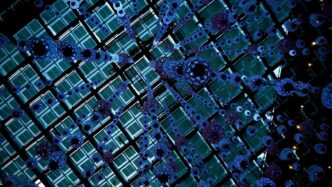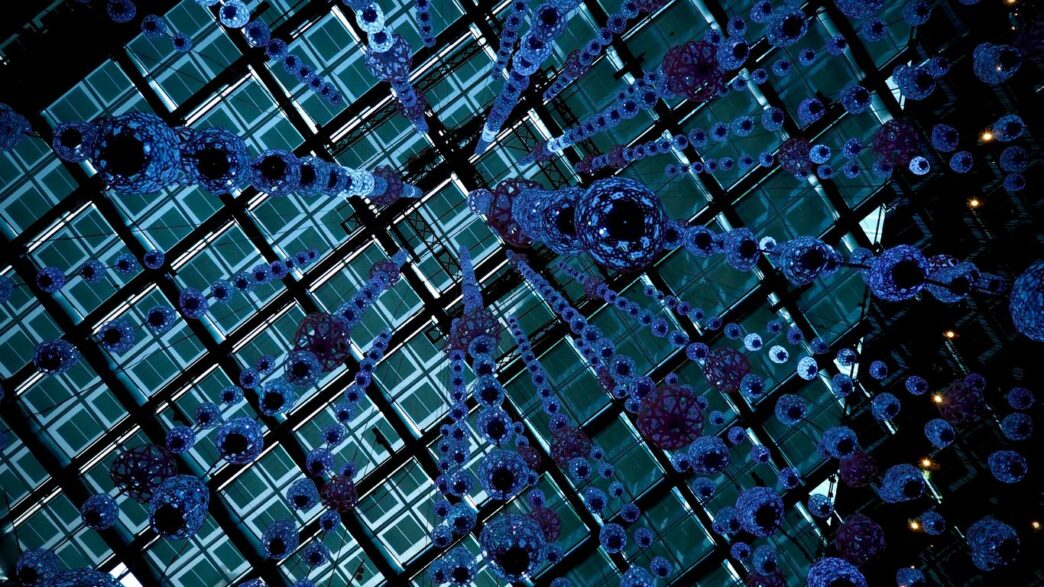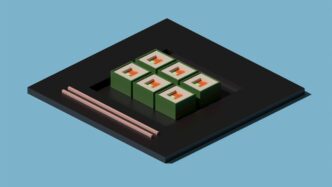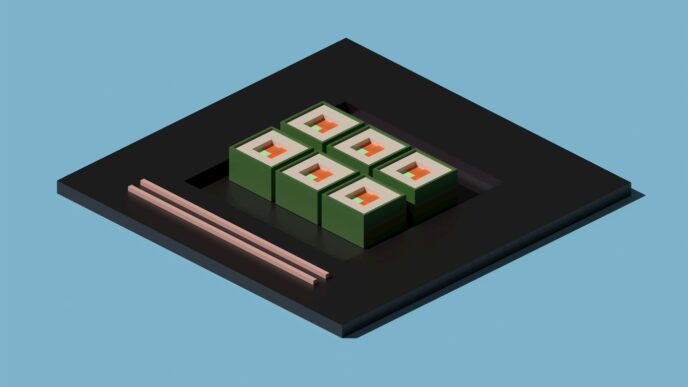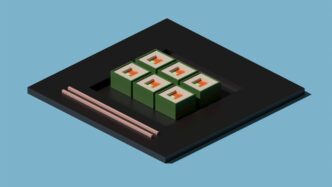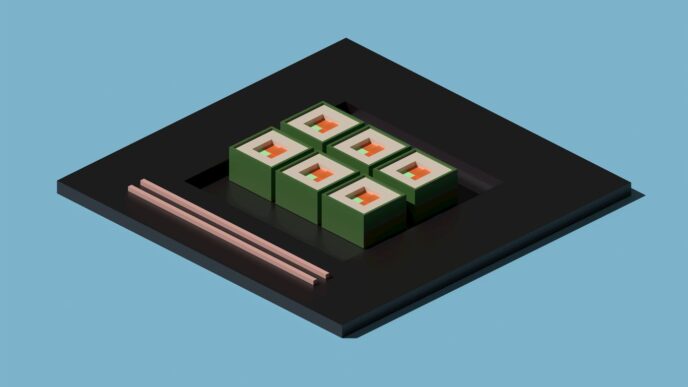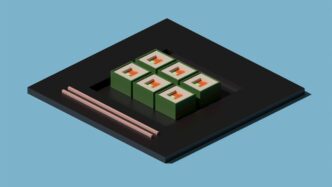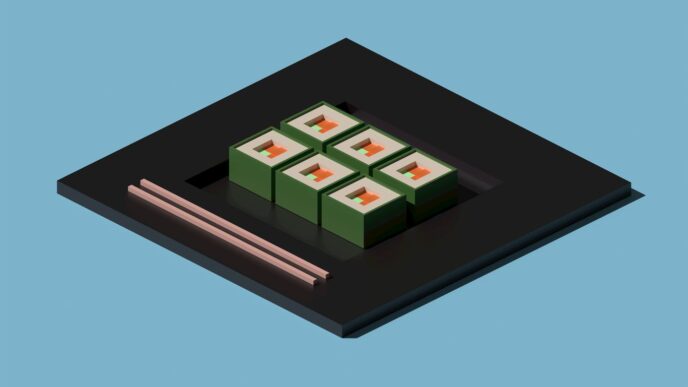Understanding The Quantum Leap: Superposition and Entanglement
Alright, let’s talk about what makes quantum computing so different from the computers we use every day. It’s not just about being faster; it’s about a whole new way of thinking about information. Classical computers, the ones in our phones and laptops, work with bits. A bit is like a light switch – it’s either on or off, representing a 1 or a 0. Simple enough, right? But quantum computers play by different rules, thanks to the weird and wonderful world of quantum mechanics.
The Nature Of Qubits: Beyond Binary
Instead of bits, quantum computers use something called qubits. Now, here’s where things get interesting. A qubit isn’t just a 0 or a 1. It can be a 0, a 1, or, and this is the mind-bending part, it can be both at the same time. Think of it like a spinning coin. Before it lands, it’s not heads or tails; it’s in a state of possibility for both. This ability for qubits to exist in multiple states simultaneously is called superposition. It’s like having a lot more options available at once, which is a big deal for computation.
Simultaneous States: The Power Of Superposition
So, what does this superposition thing actually do for us? Well, imagine you have a problem with many possible solutions. A classical computer has to check each solution one by one. A quantum computer, using superposition, can explore many of these possibilities all at once. It’s like being able to try out every path in a maze simultaneously instead of walking down each one individually. This parallel processing capability is what gives quantum computers their potential to tackle problems that are currently impossible for even the most powerful supercomputers.
Interconnected Fates: The Mystery Of Entanglement
Then there’s entanglement. This is another quantum phenomenon that’s pretty wild. When two or more qubits become entangled, they become linked in a special way. Their fates are intertwined, no matter how far apart they are. If you measure the state of one entangled qubit, you instantly know something about the state of the other, even if it’s across the galaxy. It’s like having two magic coins; if one lands on heads, you know the other one must be tails, instantly, without even looking at it. This spooky connection is key to how quantum computers can perform complex operations and communicate information in new ways.
Harnessing Superposition For Computational Advantage
So, how do we actually use this weird quantum stuff, like superposition, to get computers to do cool things? It’s not like flipping a light switch anymore. Instead of just ‘on’ or ‘off’, a qubit can be both at the same time. Think of it like having a coin spinning in the air – it’s neither heads nor tails until it lands. This ability to be in multiple states at once is where the real power comes from.
Parallel Processing Through Quantum States
This is where things get really interesting. Because a qubit can represent both 0 and 1 simultaneously, a system of just a few qubits can represent a massive amount of information. If you have two qubits, they can represent four states (00, 01, 10, 11) all at once. Three qubits? That’s eight states. It grows exponentially. This means a quantum computer can, in a sense, explore many different possibilities all at the same time. It’s like trying every key on a giant keyring simultaneously instead of one by one. This inherent parallelism is what gives quantum computers their potential edge for certain problems.
Exploring Vast Possibilities Simultaneously
Imagine trying to find the best route through a city with millions of streets. A regular computer would have to check each route, one after another. A quantum computer, using superposition, can explore many of those routes at the same time. It’s not that it’s faster in the traditional sense, but it can look at a much wider landscape of potential solutions in a single go. This is incredibly useful for problems where the number of possibilities is just too huge for even the most powerful supercomputers we have today.
Accelerating Complex Calculations
When you combine this ability to explore many states at once with clever quantum algorithms, you can speed up calculations that would take classical computers ages. Think about tasks like figuring out the best way to arrange a complex supply chain, or simulating how a new drug molecule might behave. These problems have so many variables and interactions that they become practically impossible to solve with current technology. Quantum computers, by using superposition to check many scenarios at once, can potentially find the optimal solution much, much faster. It’s not magic, but it’s definitely a big leap forward for tackling some of the world’s toughest computational challenges.
Entanglement: The Quantum Connection
So, we’ve talked about superposition, where a qubit can be in multiple states at once. Pretty wild, right? But entanglement takes things to a whole new level. Think of it as a special kind of connection between two or more qubits. When qubits get entangled, they become linked in a way that their fates are tied together, no matter how far apart they are. It’s like having two coins that, when flipped, will always land on the same side, even if you flip them in different cities. This spooky connection is what allows quantum computers to perform incredibly complex tasks by coordinating information across multiple qubits instantaneously.
Correlated Qubit States
When qubits are entangled, measuring the state of one qubit instantly tells you something about the state of the other entangled qubits. It’s not that they’re sending signals to each other; it’s more like they were always destined to be in those specific states relative to each other from the moment they became entangled. This correlation is a key ingredient for building powerful quantum algorithms. We can set up these correlations in specific ways to solve problems.
Instantaneous Influence Across Distances
This is the part that really blows people’s minds. If you have two entangled qubits, say one here and one on the moon, and you measure the one here, you instantly know the state of the one on the moon. This happens faster than the speed of light, which sounds impossible, but it’s a verified aspect of quantum mechanics. It doesn’t mean we can send messages faster than light, though. The information you get from the measurement is random until you compare it with the measurement from the other qubit, and that comparison still requires classical communication.
Enabling Quantum Networks
Entanglement is the backbone for building quantum networks. Imagine a network where information isn’t just sent, but shared in a deeply connected way. This could lead to things like perfectly secure communication channels, where any attempt to eavesdrop would break the entanglement and be immediately detected. It also opens the door for distributed quantum computing, where multiple quantum processors can work together on a single problem, sharing their entangled states to achieve even greater computational power.
Applications Driven By Superposition And Entanglement

So, what does all this quantum weirdness actually mean for us? It’s not just some abstract science experiment; it’s about solving real-world problems that are just too tough for even the most powerful regular computers we have today. Think about it – we’re talking about tackling challenges that could change industries and even how we live.
Revolutionizing Optimization and Simulation
One of the biggest areas where quantum computing is set to make waves is in optimization and simulation. You know how sometimes you have a problem with a million different possible answers, and you need to find the absolute best one? That’s optimization. Classical computers can struggle with these kinds of problems, especially as they get bigger. Quantum computers, with their ability to explore many possibilities at once thanks to superposition, can potentially find those optimal solutions much faster.
This also applies to simulation. Nature itself is a quantum system, right? So, when we try to simulate things like how molecules interact or how new materials might behave, using a classical computer is like trying to draw a perfect circle with a shaky hand. A quantum computer, however, can mimic these quantum behaviors much more accurately. This could speed up the creation of new medicines or help us design better materials for everything from batteries to electronics.
Advancing Machine Learning Capabilities
Machine learning is already a huge deal, and quantum computing could give it a serious boost. Imagine training AI models much faster or allowing them to learn from way more complex data than they can handle now. Quantum algorithms could help machine learning models identify patterns that are currently hidden, leading to smarter AI for things like medical diagnosis or financial forecasting.
Transforming Cryptography and Data Security
This is a big one, and it’s a bit of a double-edged sword. On one hand, quantum computers could break a lot of the encryption we rely on today to keep our data safe. Algorithms like Shor’s algorithm are a serious concern for current security systems. But, on the flip side, quantum mechanics also offers new ways to create incredibly secure communication methods. We’re talking about quantum cryptography, which uses the principles of quantum mechanics to make sure that any attempt to eavesdrop is immediately detectable. It’s like having a secret handshake that automatically alerts you if someone tries to copy it.
Here’s a quick look at how these applications might play out:
- Optimization: Finding the most efficient routes for delivery trucks, optimizing financial portfolios, or scheduling complex manufacturing processes.
- Simulation: Designing new drugs by simulating how they interact with the body, creating novel materials with specific properties, or modeling complex weather patterns.
- Machine Learning: Developing more accurate predictive models, improving image and speech recognition, and enabling more sophisticated AI assistants.
- Cryptography: Breaking current encryption standards (a threat) and developing new, quantum-proof encryption methods (a solution).
It’s a lot to take in, but the potential is pretty mind-blowing. We’re looking at a future where problems that seem impossible today could become solvable.
The Promise Of Quantum Simulation
Nature, at its heart, plays by quantum rules. Think about how molecules interact or how materials behave at their smallest levels – it’s all governed by quantum mechanics. Trying to model these incredibly complex systems on even the most powerful regular computers is like trying to map out every single grain of sand on a beach by hand. It’s just not practical.
This is where quantum simulation comes in. By using quantum computers, which naturally operate on quantum principles, we can create digital models that mimic these natural processes much more accurately. This ability to simulate nature at its own level opens up a whole new world of possibilities.
Modeling Molecular Interactions
Understanding exactly how atoms and molecules link up and react is a huge deal for chemistry and materials science. Quantum simulations can show us these interactions in detail, something classical computers struggle with. We can predict how a new drug might bind to a protein or how a new material might conduct electricity, all before we even make it in a lab.
Accelerating Drug Discovery
Finding new medicines is a long and expensive process. A big part of that is testing how potential drug compounds interact with biological targets. Quantum computers can speed this up dramatically. Instead of years of trial and error in the lab, we could simulate countless molecular interactions virtually, identifying promising candidates much faster. This could lead to quicker development of treatments for diseases.
Understanding Natural Systems
Beyond just molecules, quantum simulation can help us grasp bigger natural phenomena. Think about complex weather patterns, the behavior of superconductors, or even the fundamental forces in physics. Simulating these systems could give us insights we’ve never had before, helping us tackle big challenges like climate change or develop new energy technologies.
Quantum Computing’s Impact On Data Security
So, we’ve talked about how quantum computers can do some pretty amazing things, but there’s a flip side to all this power, especially when it comes to keeping our digital stuff safe. It turns out that the very things that make quantum computers so special – superposition and entanglement – also create some big headaches for the way we currently protect information.
The Threat Of Shor’s Algorithm
This is where Shor’s Algorithm comes into play. Think of it like a master key that can unlock a lot of the locks we use today to keep our data secure. Most of the encryption we rely on, like RSA, is built on the idea that it’s incredibly hard for regular computers to figure out the prime factors of very large numbers. It would take them ages, like, longer than you or I will be alive, to crack it. But Shor’s Algorithm, when run on a powerful enough quantum computer, can do this factoring job in a fraction of the time. This means that sensitive information, from your bank details to government secrets, could potentially be exposed. It’s a bit like discovering that the super-strong safe you bought can actually be opened with a simple trick.
Developing Quantum-Resistant Cryptography
Because of this looming threat, a lot of smart people are working hard to create new ways to encrypt data that even quantum computers can’t break. This is called quantum-resistant cryptography, or sometimes post-quantum cryptography. It’s not just about making the numbers bigger; it’s about using different mathematical problems that are believed to be hard for both classical and quantum computers to solve. Some of the approaches being explored include:
- Lattice-based cryptography: This uses mathematical structures called lattices to create encryption keys.
- Code-based cryptography: This relies on the difficulty of decoding general linear codes.
- Hash-based cryptography: This uses cryptographic hash functions, which are generally considered more resistant to quantum attacks.
- Multivariate polynomial cryptography: This involves solving systems of multivariate polynomial equations.
It’s a race against time, really, to get these new methods ready and implemented before quantum computers become powerful enough to break current systems.
Secure Communication Through Quantum Principles
On the flip side, quantum mechanics also offers some really neat ways to improve security. One of the most exciting is quantum key distribution (QKD). Instead of relying on mathematical puzzles, QKD uses the weirdness of quantum physics, like entanglement, to share encryption keys. The cool part is that if anyone tries to snoop on the key as it’s being sent, the very act of observing it changes its quantum state. This alerts the sender and receiver that someone is listening in, and they can just discard the compromised key and try again. It’s like having a secret handshake that automatically breaks if someone else tries to copy it. This offers a level of security that’s physically guaranteed, not just computationally difficult.
The Road Ahead
So, we’ve talked about how quantum computers work, using things like superposition and entanglement to do some pretty wild calculations. It’s not like your laptop, that’s for sure. These machines could help us figure out new medicines, create better materials, or even make our internet safer. But, and it’s a big ‘but’, building these things is really hard. Keeping those tiny quantum bits stable is a major headache. Still, big companies and governments are putting a lot of money into it, so things are moving. It’s going to be a while before we all have quantum computers at home, but the changes they could bring are huge. It’s definitely something to keep an eye on as this technology keeps growing.

